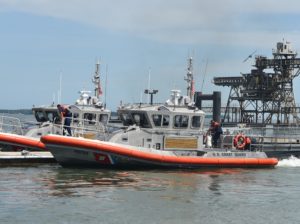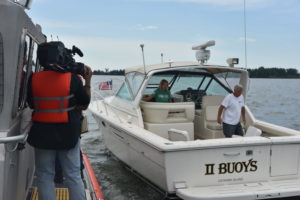
The U.S. Coast Guard’s Station Marblehead received a call from a local sheriff’s deputy on Sept. 18. The deputy reported concern about kayakers on the lake heading out during inclement weather.
A small group gathered in the station’s briefing room, including one roused suddenly from sleep, to learn about the mission. Crew members grabbed their gear and firearms and headed to a 45-foot response boat, which one member had already fired up.
Within five minutes of the call, the boat was on the water and, in another five or six minutes, in the area. But the kayakers were nowhere to be found. The USCG put out a call on the radio, and within moments a boater who had seen them pointed them in the right direction.
A mile or so southwest of South Bass Island, there was a trio of seasoned, well-prepared kayakers heading for the island in three-foot swells. They were fine. Mission accomplished.
The rain ceased, the sun emerged, and though the lake was still choppy, the crew was able to perform random safety inspection on two vessels, both larger pleasure boats in the 30- to 35-foot range.
Coasties on call all year long for rescues
Lake Erie’s Western Basin, which stretches from Sandusky Bay to Toledo and Michigan, hosts more boat traffic than any other region in the Great Lakes.
In Ottawa County alone there are estimated to be more than 14,000 individual boat slips, with thousands more in adjacent Lucas and Erie counties.
But large numbers of boaters mean large numbers of boaters running out of fuel, experiencing mechanical troubles, becoming lost, sinking, grounding, falling overboard, catching fire and suffering medical emergencies. And in winter, situations grow to include getting lost in snow squalls and falling through the ice.
That’s where the U.S. Coast Guard’s Station Marblehead comes in, ready to lend a helping hand 24/7/365.
Situated very near where the original Point Marblehead Lifesaving Station was established in 1874, the current station hosts 50-plus staff and a variety of vessels serving multiple purposes including search-and-rescue, law enforcement and safety patrols.
Boatswain’s Mate First-Class (BM1) Garrett Tryon offered Great Lakes Now a tour of the facility.
“We definitely want the station to look good to the public because that’s who we’re here to serve,” he said.
The tour covered all things Station Marblehead, including the briefing room, armory and watch room, which offered an expansive view of the lake through a bank of large windows.
“This room is where we literally watch,” Tryon said. “It’s here where we monitor the radio traffic and take calls. And here, of course, we can actually see the lake – exactly what it’s doing at any given moment.”
Watch room is the point of contact
Fred Overholt, a USCG auxiliary member on duty in the watch room, offered up his insight into using a paper chart to help locate boats and people on the water.
In just a few moments he demonstrated how with map and compass, and using a vessel’s last known location, he could estimate a current vessel location or likely location of a person overboard. Up-to-the-minute weather and water data, combined with centuries-old methods, he explained, can help establish the best place for rescuers to begin a search.

A woman and her dog were rescued from a boat hard aground a Lake Erie break wall near Marblehead, Photo provided by USCG
“We’re basically the 911 operator for maritime here,” Overholt said. “When a call comes over the radio, you never know. A woman calls and says ‘My husband’s having a heart attack. I need help!’ or the mundane: lost in a storm, hitting rocks, hitting deadheads.”
According to Overholt, Station Marblehead is never boring.
“There’s someone out there every day of the year, I don’t care if it’s storming. The real die-hard fishermen are out there every day of the year. I’ve seen ice out two miles and there’s a little patch of open water out there and then you’ll see a guy out there in a little flat bottom and there he is, motoring across the open water with a little tiny outboard,” Overholt said, shaking his head. “I say ‘Don’t be out there fishing in weather like that.’ But they do.”
According to Brian McCrum, with the USCG Ninth District Public Affairs office, Station Marblehead is officially busy.
“It’s one of only two small boat stations on the lakes that is mandated to have two full boat crews ready to launch at all times during the summer,” he said. “So even when they are on duty and the whole workforce is not at the station, rather than having one boat crew on stand-by at all times, they need two.”
McCrum said in 2018 the station had 99 search-and-rescue missions and 1,042 law enforcement cases.
Even though the busiest portion of the 2019 boating season in the Western Basin has passed, the station is still hopping. On Sept. 21 members rescued a woman and her dog from a 31-foot vessel after it ran hard aground on a break wall on Catawba Island. A day later at about 4 a.m. a 17-foot vessel capsized in a Catawba marina sending seven people into the water. All were pulled to safety.
Station works with commercial companies and volunteers
The USCG Auxiliary is a volunteer support organization which helps Station Marblehead and others fulfill their missions. That sometimes includes manning the watch room, like Overholt, or preparing meals and helping out at public events like festivals, exhibits and educational appearances.
One of those auxiliary members is Diane Campbell, who drove from Fort Wayne, Indiana recently to spend a few days cooking at Station Marblehead.
“I drove from Indiana because Station Marblehead needed a little help,” she said, citing a temporary staff shortage. “I usually stay two or three days. But there’s one station where I stayed a month. It really just depends on what the needs of the station are.”
The USCG also works closely with commercial towing and salvage companies.
Those operators are called when boaters encounter trouble on the water and need help. While the USCG responds to all distress calls, they sometimes refer boaters to private enterprises. Towing operators most often resolve issues like on-the-water breakdowns, empty fuel tanks and soft groundings. But if there is a safety issue, the USCG takes the lead.
“A lot of times the tow captains can’t go out,” explained BM1 Victoria Martin. “If it’s really crappy out, they’ll call us and say ‘We just can’t get them.’”
Martin said that while she and Marblehead crews could assist with groundings and other non-emergency situations, they sometimes don’t.
“There are a number of towing and salvage companies and this is their bread and butter, and that’s okay,” she said. “We’re not out here to take away business from commercial companies – but we’re always here to help in emergencies.”
Routine safety checks ho-hum, but necessary
“We see a lot of boats with kids on board,” said BM1 Justin VanDusen, idling the response boat near a 40-foot pleasure boat while two crew members performed an inspection. “Just making sure they have everything on board, that they’re not intoxicated. The main thing is making sure they have life jackets and they’re the right kind. A lot of times we see boats with adult lifejackets for kids.”
During random safety boardings, vessels are checked for safety items and required gear such as lines, anchors, flares, bailing devices and lighting.
VanDusen said the size or price or style of boat doesn’t influence USCG inspections. On-the-water inspections are truly random. Just like calls to the watch room.
In 2012, a call received from a pilot flying over the Western Basin made national news. The pilot, who reported a sinking boat setting off rescue flares, fabricated the story. Dozens of USCG members and their Canadian counterparts spent hundreds of man-hours in airplanes, helicopters and boats searching the water. A criminal charge was laid and eventually, a $450,000-plus fine.
In March, a group of more than three dozen ice anglers were pulled from a break-away ice floe near Catawba by USCG boats and a helicopter. In 2009, a similar situation made international news when more than 125 anglers had to be rescued from an ice floe in western Ottawa County more than a mile offshore.
“Growing up as a kid my parents always told me to stay off the ice and, after starting my tour here, I can say that was good advice,” Tryon said. “It’s definitely not safe to be out there. It’s very unpredictable, and you never know what it’s going to do.”
After spending several hours on the water and making no arrests and issuing no citations over the course of his shift, Tryon described the day as perfect.
“That’s a great day for us at Station Marblehead,” he said. “The kayakers were out there being safe. They knew what they were doing and had all their safety equipment on board, and they were having good time and we love to see that. Same thing with the two boats we inspected.
“Anytime people are enjoying the lake responsibly, we love it.”
Featured Image: Keeping an eye on things in Station Marblehead’s watch room, Photo by James Proffitt







